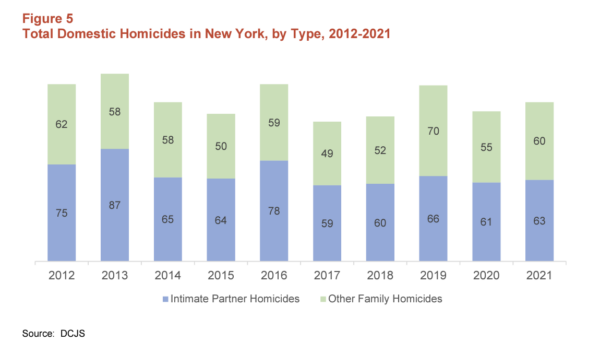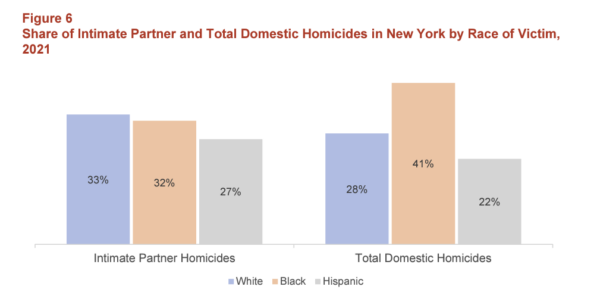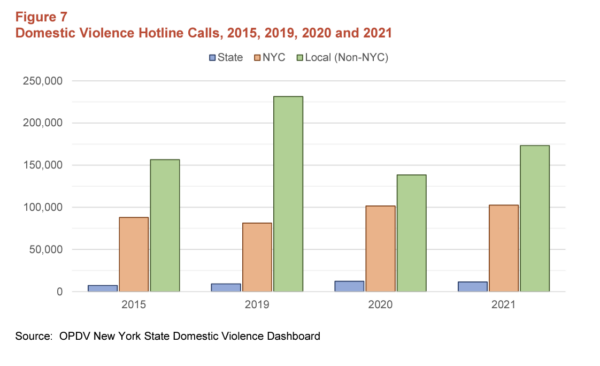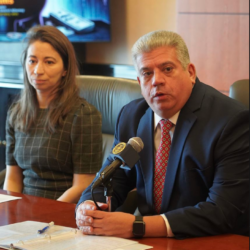
State Comptroller tracks domestic violence cases and their impact on government efficiency
Many elements of support for victims
and prosecution of offenders
are more costly if not coordinated

Images courtesy of the NYS Comptroller’s Office
 The number of domestic violence victims increased in 2022 by 8.5% in New York City and 8.7% in the rest of New York state when compared to 2019, according to an analysis by State Comptroller Thomas P. DiNapoli. October is Domestic Violence Awareness Month. According to the Centers for Disease Control and Prevention, 1 in 4 women and 1 in 10 men have experienced sexual violence, physical violence, and/or stalking by an intimate partner during their lifetime.
The number of domestic violence victims increased in 2022 by 8.5% in New York City and 8.7% in the rest of New York state when compared to 2019, according to an analysis by State Comptroller Thomas P. DiNapoli. October is Domestic Violence Awareness Month. According to the Centers for Disease Control and Prevention, 1 in 4 women and 1 in 10 men have experienced sexual violence, physical violence, and/or stalking by an intimate partner during their lifetime.

“Domestic violence has a devastating effect on individuals and families, often causing permanent physical injury and emotional trauma,” DiNapoli said. “With increased numbers of domestic violence victims across the state over the past three years, it’s important to know how to get help and how to identify signs of trouble. State and local agencies also must redouble their efforts to make seeking help and receiving services as easy as possible for victims.”
In both New York City and the rest of the state, close to 70% of all domestic violence victims were hurt by their intimate partner, with 80% of intimate partner victims being female. Women were 54% of domestic homicide victims, a rate nearly five times greater than for non-domestic homicides. Victims of domestic homicide were more often Black than other racial or ethnic categories (41%, compared to 28% White and 22% Hispanic). These rates have remained relatively consistent over the past decade.

Need for Domestic Violence Services On the Rise
The number of calls received by domestic violence and sexual assault hotlines statewide increased by 28% from 2015 to 2019. During 2020 and 2021, State Domestic & Sexual Violence Hotline calls increased by 32% and calls to the New York City Domestic Violence Hotline grew 26%. Calls to other local domestic violence hotlines declined by 40% in 2020, resulting in an overall decrease in hotline calls. Admissions to domestic violence shelters rose between 2015 and 2019 by 8%, but declined 13% between 2019 and 2021, potentially due to barriers accessing services during the pandemic.

DiNapoli’s analysis also found:
- In 2022, the State Division of Criminal Justice Services reported 39,224 domestic violence victims in New York City (an increase of 4,297 or 12% from 2021) and 49,598 in the rest of the state (an increase of 766 or 2% from 2021). Because the state and the city use different offense classifications, these figures cannot be combined to derive a total statewide count.
- Simple Assault accounted for 80% of the reports in counties outside of New York City. In New York City, where reports of domestic violence victims are classified under different charges, Assault Third Degree & Related Offenses accounted for 40% of all domestic violence reports in 2022.
- In 2022 in New York City, 30% of domestic violence reports were for violations of Protective Orders, while in the rest of the State Violations of Protective Orders make up only 8% of reports. Although counties outside the city issue roughly the same or more protective orders involving intimate partners or family members than New York City, the lower share of reported violations accounting for domestic violence incidents may merit further investigation.

Every county in New York state has a domestic violence program that offers safe housing and other services to victims, including counseling, transportation, legal advocacy, mental health treatment, and other support, including public benefits and financial assistance.
The Office of the State Comptroller is engaged in an audit focused on whether domestic violence programs and services are effectively coordinated between agencies to provide needed resources and support to domestic violence victims. The audit will be released in the coming months.
Analysis
Economic and Policy Insights – Domestic Violence: Recent Trends in New York
Leave a Comment
Related Articles


Premium Content
How Brooklyn DA’s Virtual Currency Unit disrupts major cryptocurrency scam

Brooklyn residents’ losses in global cryptocurrency scam brought DA Gonzalez into action

NYC subway conductor slashed in the neck in Bed-Stuy
Leave a Comment
The Brooklyn Daily Eagle and brooklyneagle.com cover Brooklyn 24/7 online and five days a week in print with the motto, “All Brooklyn All the Time.” With a history dating back to 1841, the Eagle is New York City’s only daily devoted exclusively to Brooklyn.
© 2024 Everything Brooklyn Media
https://brooklyneagle.com/articles/2023/10/19/state-comptroller-tracks-domestic-violence-cases-and-their-impact-on-government-efficiency/

